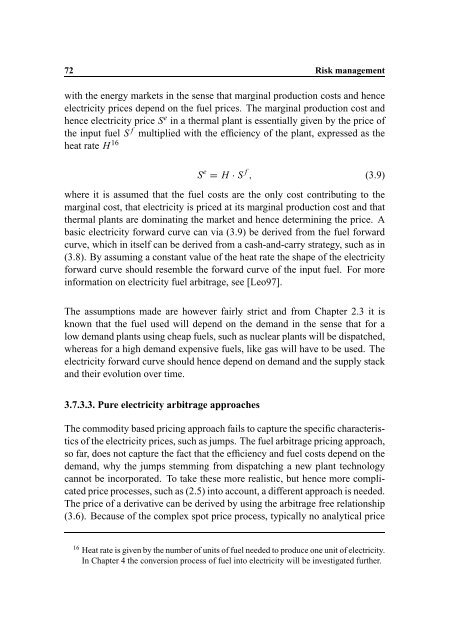Hedging Strategy and Electricity Contract Engineering - IFOR
Hedging Strategy and Electricity Contract Engineering - IFOR
Hedging Strategy and Electricity Contract Engineering - IFOR
Create successful ePaper yourself
Turn your PDF publications into a flip-book with our unique Google optimized e-Paper software.
72 Risk management<br />
with the energy markets in the sense that marginal production costs <strong>and</strong> hence<br />
electricity prices depend on the fuel prices. The marginal production cost <strong>and</strong><br />
hence electricity price S e in a thermal plant is essentially given by the price of<br />
the input fuel S f multiplied with the efficiency of the plant, expressed as the<br />
heat rate H 16 S e H S f G (3.9)<br />
where it is assumed that the fuel costs are the only cost contributing to the<br />
marginal cost, that electricity is priced at its marginal production cost <strong>and</strong> that<br />
thermal plants are dominating the market <strong>and</strong> hence determining the price. A<br />
basic electricity forward curve can via (3.9) be derived from the fuel forward<br />
curve, which in itself can be derived from a cash-<strong>and</strong>-carry strategy, such as in<br />
(3.8). By assuming a constant value of the heat rate the shape of the electricity<br />
forward curve should resemble the forward curve of the input fuel. For more<br />
information on electricity fuel arbitrage, see [Leo97].<br />
The assumptions made are however fairly strict <strong>and</strong> from Chapter 2.3 it is<br />
known that the fuel used will depend on the dem<strong>and</strong> in the sense that for a<br />
low dem<strong>and</strong> plants using cheap fuels, such as nuclear plants will be dispatched,<br />
whereas for a high dem<strong>and</strong> expensive fuels, like gas will have to be used. The<br />
electricity forward curve should hence depend on dem<strong>and</strong> <strong>and</strong> the supply stack<br />
<strong>and</strong> their evolution over time.<br />
3.7.3.3. Pure electricity arbitrage approaches<br />
The commodity based pricing approach fails to capture the specific characteristics<br />
of the electricity prices, such as jumps. The fuel arbitrage pricing approach,<br />
so far, does not capture the fact that the efficiency <strong>and</strong> fuel costs depend on the<br />
dem<strong>and</strong>, why the jumps stemming from dispatching a new plant technology<br />
cannot be incorporated. To take these more realistic, but hence more complicated<br />
price processes, such as (2.5) into account, a different approach is needed.<br />
The price of a derivative can be derived by using the arbitrage free relationship<br />
(3.6). Because of the complex spot price process, typically no analytical price<br />
16 Heat rate is given by the number of units of fuel needed to produce one unit of electricity.<br />
In Chapter 4 the conversion process of fuel into electricity will be investigated further.
















